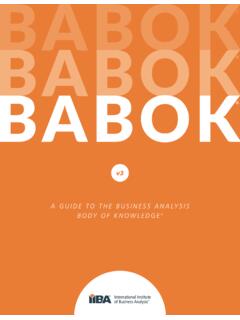Transcription of ArchiMate Cookbook - hosiaisluoma.fi
1 ArchiMate Cookbook Patterns & Examples Document information Version Created 2019-07-20 Modified 2021-07-13 Author Eero Hosiaisluoma (EHo) ArchiMate Cookbook Patterns & Examples Eero Hosiaisluoma 2 Table Of Contents 1. Introduction ..4 Purpose And Scope ..4 References ..4 2. ArchiMate Diagram Types ..5 Motivation View (Goals View) ..5 Motivation View - Example ..6 Risk Analysis Business Model View ..8 Business Model Canvas (BMC)..8 SWOT Analysis View ..8 Value Stream View ..9 Strategy & Capability View.
2 11 Implementation Roadmap Layered View ..16 Layered View - Business- and Application Layers Example ..17 Layered View - Business Layer ..17 Layered View - Customer Service Journey ..18 Layered View - Swimline Process View ..19 Layered View - Service Design View ..19 Layered View - Service Blueprint ..21 Interaction View (Co-operation View) ..22 Actor Interaction (Co-operation) View ..22 Process Interaction (Co-operation) View ..23 Application Interaction (Co-operation) View ..23 Business Process View ..23 Business Process Functional Decomposition View.
3 24 Conceptual Data Model Data Model View ..25 Technology Platform View (Infrastructure View) ..26 Application Structure View (Solution architecture View) ..27 Application Design Pattern (Basic Model) ..27 Application Logical Structure View (Application Structure / Internal Structure) ..28 Component Model (CM) ..29 Application Integrations ..32 Sequence Diagrams ..33 Application Integration Use Case View ..36 3. ArchiMate -Elements (subset) ..38 ArchiMate Motivation -Elements ..39 ArchiMate Strategy -Elements.
4 40 ArchiMate Cookbook Patterns & Examples Eero Hosiaisluoma 3 ArchiMate Business Layer -Elements ..41 ArchiMate Application Layer -Elements ..42 ArchiMate Technology Layer -Elements ..43 4. ArchiMate Relationships ..44 5. Metamodel ..46 Metamodel - Core ..46 Metamodel - Full ..47 6. Diagram Types ..48 Basic Views ..49 Business Model Views ..49 Customer Views ..49 Solution architecture Views ..50 7. Frameworks, Methods & Lean EA Framework (LEAF) ..51 Lean EA Development (LEAD) ..52 Goal-Driven Approach (GDA).
5 53 Service-Driven Approach (SDA) ..54 ArchiMate 1-2-3 ..56 EA Content Frameworks ..57 Layered Framework ..57 Aspect-Oriented Framework ..57 Views & Maps Framework ..57 SIPOC (Suppliers, Inputs, Process, Outputs, Customers) ..58 8. Appendixes ..59 Appendix 1: Cloud Service Models ..59 Appendix 2: Modelling Tips & Tricks + Extra Patterns ..59 Line Width And Color ..59 Legend ..60 Grouping ..60 Abstracting Elements ..60 enterprise Application Integration (EAI) patterns ..61 Information Resource ..62 API (Application Programming Interface).
6 63 Layered Process View ..64 ArchiMate Cookbook Patterns & Examples Eero Hosiaisluoma 4 1. Introduction Purpose And Scope This document covers ArchiMate -patterns and examples, those of which can be used for modelling concepts and solutions related to the development work of an organization. Almost all the business relevant behavioral and structural elements of an organization can be modelled with the ArchiMate . ArchiMate is a comprehensive and powerful notation, with a wide range of elements and relationships. However, only a subset of ArchiMate -elements and only a small set of diagram types are enough for most of the modelling purposes (80% of the cases).
7 This document introduces the most useful diagram types and related ArchiMate -elements. This subset of ArchiMate -elements is grouped into the layers of ArchiMate Framework (figure below). Figure 1: ArchiMate Framework. The diagrams in this document are modelled according to ArchiMate specification [1]. More ArchiMate -examples can be found from the blog [2]. This document is updated continuously, more interesting topics are to be added, and existing content is to be updated according to new information. This document can be freely used and shared.
8 References [1] ArchiMate , Open Group, 2019. [2] enterprise architecture at Work, 4th Edition, Marc Lankhorst et al., Springer, 2017. [3] Mastering ArchiMate , Edition III, Gerben Wierda, 2017. [4] Lean enterprise architecture Method For Value Chain Based Development In Public Sector, Hosiaisluoma et al, 2018. [5] ArchiMate Examples blog, Eero Hosiaisluoma. [6] Holistic enterprise Development blog, Eero Hosiaisluoma [7] ArchiMate Cookbook blog, Eero Hosiaisluoma [8] Value analysis with Value Stream and Capability modeling, Christine Dessus, 2019, ArchiMate Cookbook Patterns & Examples Eero Hosiaisluoma 5 2.
9 ArchiMate Diagram Types Motivation View (Goals View) Figure 2: Motivation View - Design Pattern. A Motivation View ( Goals View) can be used to depict why demand is meaningful: WHY this change is needed. With the Motivation View it is possible to model crucial drivers and root causes behind the demand, actual goals and related outcomes, as well as concrete requirements for further development. The Motivation View answers the questions to WHOM, WHY and WHAT. Whenever appropriate, a Value can be associated with the Motivation View, if it is important to illustrate the concrete benefits of the demand (development target).
10 This diagram type is modelled with ArchiMate Motivation- and Strategy -elements. ArchiMate Cookbook Patterns & Examples Eero Hosiaisluoma 6 Motivation View - Example Figure 3: Motivation View - Example. The Motivation View can be applied to many kinds of purposes, such as to depict a strategy of the whole organization or to define the business case or requirements of a single development target. ArchiMate Motivation- and Strategy -elements are quite self-descriptive when illustrated within the titled groups (as shown in the figure above).

